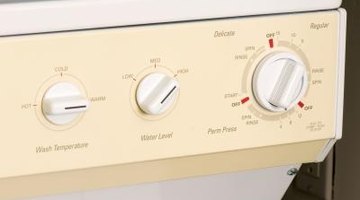Why Is Detergent a Base?
Detergent was first created in 1916 as a response to fat shortages caused by World War I. Constant improvements have been made in its cleaning power. A primary consideration for the past several decades is the environmental impact of detergent chemicals.

Creation
When a fat or oil is mixed with chemicals such as sodium or potassium hydroxide, it produces fatty acid salts -- also known as soap. The alkaline to acid, or base, scale runs from 1 to 14, with the alkaline compounds from 1 to 6 and base compounds 8 to 14. Compounds that are 7 are considered neutral. Sodium, potassium hydroxide or other substitute chemicals fall on the high side of the alkaline/acid measurement.
Chemical Compounds
By definition this makes any compound derived from these chemicals an acid or base compound. Detergent merely replaces the fat with a synthetic surfactant, leaving the rest of the process virtually the same. Detergents are not quite 11 on the scale, with ammonia being a little under 12 and bleach a little over.
pH Scale
The compounds in detergent both wet the clothing and surround the oils and dirt on the clothing surface. This lifts the stains away from the surface and deposits them into the water. This process uses the portion of the detergent called the surfactant.
The Drip Cap
- Detergent was first created in 1916 as a response to fat shortages caused by World War I.
- Constant improvements have been made in its cleaning power.
- Compounds that are 7 are considered neutral.
- The compounds in detergent both wet the clothing and surround the oils and dirt on the clothing surface.
References
Writer Bio
Jack Burton started writing professionally in 1980 with articles in "Word from Jerusalem," "ICEJ Daily News" and Tagalong Garden News. He has managed radio stations, TV studios and newspapers, and was the chief fundraiser for Taltree Arboretum. Burton holds a B.S. in broadcasting from John Brown University. He is a 26-year veteran of the U.S. Navy/Navy Reserves and the Navy Seabees.
Photo Credits
- Jupiterimages/Photos.com/Getty Images
- Jupiterimages/Photos.com/Getty Images
More Articles



